
Yokohama
 Yokohama |
SKYLINES AND VIEWS: |
||||
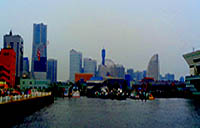 |
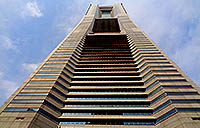 |
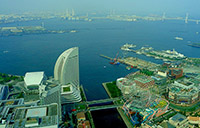 |
||
Skylines and views |
Landmark Tower |
and its views |
||
| CENTRAL Yokohama: |
Landmark Plaza, Minato Mirai 21 | Views from Landmark Tower | ||
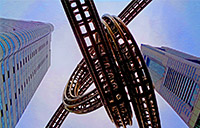 |
 |
|||
| Minato Mirai 21 Port of Yokohama |
Yokohama Station area |
Nissan Global HQ | ||
Cosmo World Amusement Park, Cosmo Clock, Yokohama Red Brick Warehouse, Queens Square, Yokohama Bay Bridge |
Yokohama Station, Sogo, River | Nissan cars | ||
 |
 |
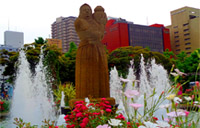 |
||
| City center |
Chinatown | Yamashita Park | ||
Yokohama Park, Yokohama Stadium |
Chūkagai odori, Goodwill Gate, Eastern Gate |
Hikawa Maru ship, |
||
 |
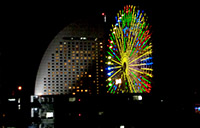 |
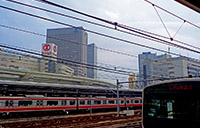 |
||
| Yokohama by night | Train to Yokohama Outskirts, other cities |
|||
| Minato Mirai 21, City center, Chinatown, Sakuragicho Station, Yokohama Stadium | KAWASAKI, KANAGAWA, OTU | |||
 |
|
Population: 3 732 000 (Tokyo metro 38 305 000) |
Yokohama is the second largest city in Japan. It is also the most important port in the country, even ahead of Tokyo. The city is just a few km south of the capital, facing Tokyo Bay. It is part of the most populous metropolitan area of Japan, Tokyo. Yokohama literally means ”horisontal beach”. On clear days, Mount Fuji can be seen from the city’s tallest buildings. Ooka River is one of the rivers that flows through the city. Nakamura is the other one. Yokohama was originally a fishing village, but grew significantly when the large port opened in 1859. Minato Mirai 21 (MM) is the central business district and modern harbourfront skyline of Yokohama. It attracts numerous tourists each year, and most of Yokohama’s skyscrapers can be found in the MM area. Minato Mira literally means "future harbour". The circular Shin-Yokohama Prince Hotel (42 floors) is situated in another district, Shin-Yokohama west of the city center. Here you find the large Shin-Yokohama Station. Nissan Motors, JGC Corporation, Chiyoda Corporation all have headquarters in Minato Mirai. Nissan has a large store with a showroom open for public, part of the Nissan Global Headquarters in Minato Mirai. Nissan Stadium is an important stadium that opened in 1992 and has the highest seating capacity of all stadiums in Japan (72 327). It has been used for football, rugby, athletics, concerts and more. Yokohama Stadium is a large circular stadium in the city center. It opened in 1978 for baseball in the middle of the Yokohama Park and has a capicity of 30 000 people. Yokohama Red Brick Warehouse, also on Shinko island, is a redbrick building complex, reminding of British warehouse buildings, facing the water. It was originally used as a customs building but is now a shopping mall, banquet hall, and event venues. The complex consist of two similar buildings facing each other. They were built in 1911 and 1913. The large postmodern mall Yokohama World Porters with about 200 stores is next to it. Navios Yokohama is a postmodern hotel building with a gate right through the building. Port of Yokohama is the most prominent port in Japan. Yokohama Bay Bridge is a beautiful white cable stayed bridge. It is 860m long, 172m tall and opened in 1989. Osanbashi Pier is a modern international pier where huge cruise ships dock. It has a futuristic internatinonal passenger terminal. Chinatown (Yokohama Chūkagai ) in Yokohama is the largest Chinese district outside China. It is situated right in the city center and has two beautiful gates (Goodwil Gate and Eastern Gate). It has pedestrian streets filled with nice Chinese restaurants, markets and shops, beautifully illuminated with numerous neon signs after dark. Kwan Tai Temple is also situated here. It is the nicest and most lively part of Yokohama. It has a 150 year long history, but today only a few Chinese people live in Chinatown after the big 1923 earthquake and conflicts. Yokohama has subway and buses. Yokohama Municipal Subway opened in 1972 and has two lines and 42 stations. There are 3 large railway stations; Yokohama (Central), Shin-Yokohama (West) and Sakuragicho Station (harbour). The Yokohama Central Station is the busiest station in Kanagawa prefecture and the 5th busiest in the world (2013)! MY EXPERIENCE: We made a daytrip to Yokohama during our trip to Tokyo in May 2018. I takes just about one our by train from Shinagawa Station in Tokyo. Even though the city is very large, the city center and waterfront area is compact and it is easy to walk around. There are many large roads and highways, but also pedestrian bridges and tunnels that make it accessible. Yokohama feels more continental and has more palms then Tokyo. |